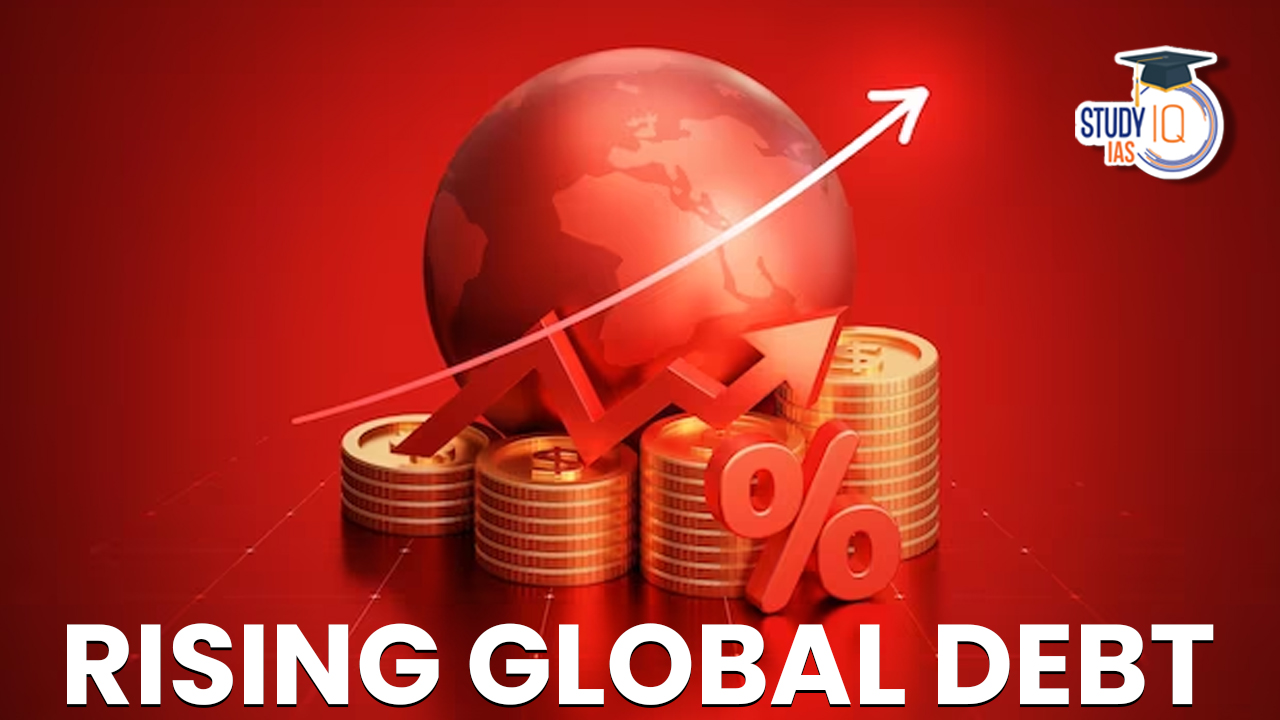Table of Contents
Context: According to the Institute of International Finance (IIF), global debt rose to an all-time high of $307 trillion in the second quarter of 2023.
What is Global Debt?
- Global debt refers to the total amount of money borrowed by governments, private businesses, and individuals worldwide.
- It encompasses both public debt (government borrowings) and private debt (borrowings by businesses and individuals).
- Governments typically borrow to finance various expenditures, such as infrastructure projects, social programs, and budget deficits, when their tax and revenue income is insufficient.
- Private sector borrowing is primarily used for investments, including business expansion and consumer purchases.
Current Status of Global Debt
- Both global debt in nominal terms and global debt as a share of GDP have been rising steadily over the decades.
- As of the second quarter of 2023, global debt reached a record high of $307 trillion, according to a report by the Institute of International Finance (IIF).
- During the first half of 2023, total global debt rose by $10 trillion.
- Most (over 80%) of the rise in global debt in the first half of the year has come from advanced economies such as the U.S., the U.K., Japan, and France.
- Among emerging market economies, China, India and Brazil have seen the most growth in debt.
- At the start of 2023, experts at the World Economic Forum warned that the global rise in public debt was a ‘fiscal ticking bomb’.
- Over the past decade, global debt has increased by approximately $100 trillion.
- The debt-to-GDP ratio, which measures debt relative to a country’s economic output, has also started to rise again, reaching 336%.
Why is Global Debt Rising?
- Government Spending: Governments have been borrowing to fund various initiatives and address budget deficits. This trend has been exacerbated by the economic challenges posed by events like the COVID-19 pandemic.
- Low interest rates: Central banks around the world have kept interest rates low for over a decade to stimulate economic growth. This has made it cheaper for governments and businesses to borrow money, which has led to an increase in debt levels.
- Private sector investment: Businesses have borrowed money to invest in new projects and expand their operations. This has also helped to drive up global debt levels.
- Inflation: Rising inflation can help governments reduce the real value of their debt, as the debt remains fixed while the value of currency decreases. This phenomenon is known as inflating away debt.
Implications of Rising Global Debt
- Debt Sustainability: High levels of debt can raise concerns about a country’s ability to service its obligations, potentially leading to default or efforts to inflate away the debt.
- The IIF has warned that the international financial infrastructure is not equipped to handle unsustainable domestic debt levels.
- Crowding out: High debt levels can crowd out private investment. This means that governments and businesses may be competing for the same pool of savings. This can lead to higher interest rates and make it more difficult for businesses to invest.
- Inflation: If governments borrow too much money and are unable to repay it, they may resort to printing money. This can lead to inflation, which can erode the purchasing power of households and businesses.
- Economic Crises: Generally, rapidly rising private debt levels are linked to unsustainable booms that end in economic crises when such lending is not backed by genuine savings.
- Recent example of the same was the 2008 global financial crisis. The crisis was immediately preceded by an economic boom fuelled by the U.S. Federal Reserve’s easy credit policy.
India’s Debt Scenario
- Debt ratio – As per International Monetary Fund, India’s debt ratio projected to be 84% of its GDP in 2022.
- Fiscal Deficit – The fiscal deficit stands at 6.4% of GDP, India aims to keep the same fiscal deficit in 2023.
- The fiscal deficit in 2020-21 increased to 13.3% and the aggregate public debt to 89.6%.
- As the economy recovered after the pandemic, the deficit and debt ratios have receded to 8.9% and 85.7%, respectively.
- External debt – India’s External debt stands at 18% of GDP as per RBI for the FY 2023.
- Loans remained the largest component of external debt, with a share of 32.5%, followed by currency and deposits (22.6%), trade credit and advances (19.9%) and debt securities (16.7%)


 Crime Against Humanity (CAH Treaty)
Crime Against Humanity (CAH Treaty)
 Languages of the World List, Most Spoken...
Languages of the World List, Most Spoken...
 Hindu Marriage Act 1955, Salient Feature...
Hindu Marriage Act 1955, Salient Feature...




















